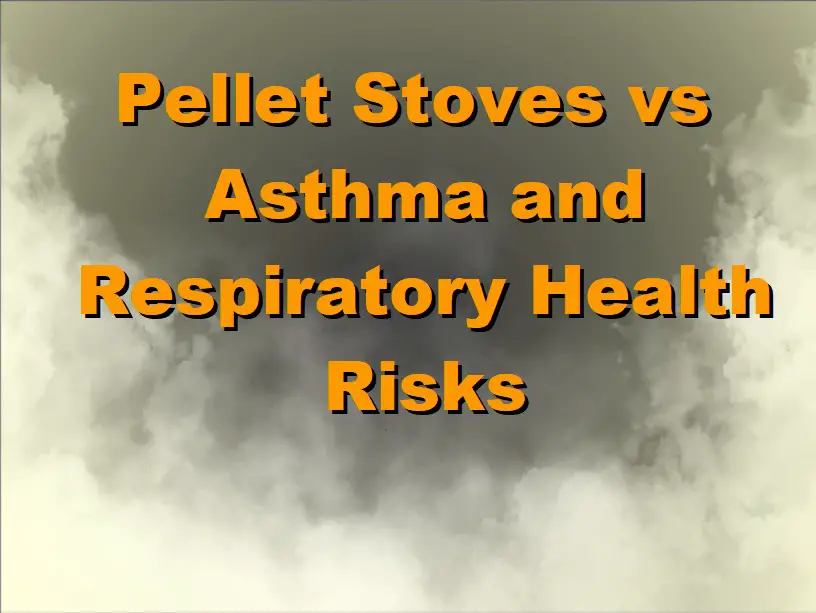Because Pellet stoves burn biomass waste products (like compressed sawdust pellets) they are known as an environmentally friendly heating source, which is one of the attractions for them becoming increasingly popular. Environmental friendliness is great, however there are some concerns with operating pellet stoves that people with respiratory conditions such as asthma and COPD should be aware of.
This article will look to identify the risks of airborne particulate matter, and offer some suggestions to reduce those risks so that people with respiratory conditions can enjoy their pellet stoves in the knowledge they are doing so safely.
It’s important for those with respiratory conditions to be aware of these risks and take steps to manage their symptoms while using a pellet stove, such as proper maintenance, installation and operation, in addition to choosing a stove with low emissions.
The toxic emissions produced by Pellet stoves can trigger symptoms of asthma in some circumstances. Leaking smoke, airborne pellet dust, and airborne ash can create dangerous situations for people with respiratory conditions. Many of these dangerous substances can be classified as air pollutants. They become dangerous because they are so fine that they become suspended in air and therefore easily inhaled. These fine inhalable particulates are known as PM2.5.
The good news is that this study from NC State University claims that pellet stoves significantly reduce pollutant emissions over conventional wood stoves used for cokking..
What is PM2.5
PM2.5, is particulate matter 2.5 micrometers or less in diameter. These tiny particles can easily enter the lungs and cause health problems, including worsening respiratory conditions such as asthma and COPD. Pellet stoves emit PM2.5 as a result of incomplete combustion of the wood pellets, which can happen if pellets are not properly burned, dust is created by pellets rubbing together and released when being loaded into the hopper, or when ash is being removed.
How to minimize the respiratory risks when operating a pellet stove
It’s important for those with respiratory conditions or those considering using a pellet stove to be aware of the potential for PM2.5 emissions and take steps to minimize exposure, such as properly maintaining and operating the stove, choosing a stove with low emissions, and ensuring proper ventilation.
Using an air purifier to reduce airborne particulate matter
Using an air purifier in conjunction with a pellet stove can be an effective way to reduce exposure to harmful particulate matter and other irritants that may be present in the emissions.
An air purifier works by drawing in air, passing it through a filter, and then returning the cleaned air back into the room. There are different types of air purifiers available. The most effective of which contain a HEPA (high-efficiency particulate air) filter. HEPA filters are particularly effective at removing PM2.5 particles. These filters can capture particles as small as 0.3 microns with an efficiency of 99.97%.
When shopping for an air purifier, it’s important to look for one that is specifically designed to remove PM2.5 particles. Some air purifiers may be labeled as “HEPA-type,” but these do not necessarily have the same efficiency as a true HEPA filter. Before buying an air purifier make sure you have calculated the air volume of the room where it will be located. Too small an air purifier will not be able to effectively clean the air.
Important note, don’t forget to follow the manufacturer’s recommendations for filter maintenance and replacement.
Air purifiers should although effective can be used in combination with other strategies for best results. Keep reading below to see what else you can do to managing respiratory risks when operating a pellet stove.
Wear a dust mask when filling and wash hands after filling the hopper
Another important preventative measure is to wear a dust mash when filling the hopper. When in motion (as when moving bags or loading) the pellets will be crashing into each other. This will damage the pellets slightly releasing small pieces, sometimes dust that will be small enough to become airborne. It is therefore inevitable that some of the dust will be inhaled.
If you are susceptable to respiratory conditions we suggest wearing a dust mask. An N95 dust mask will reduce PM2.5 by approximately 95%, an N99 dust mask will reduce PM2.5 by approximately 99%.
Before you take off the mask make sure you wash your hands thoroughly after filling the hopper. Handling the pellets when loading can leave small amounts of PM2.5 on your hands, which can transfer to your clothing and later become airborne and then inhaled.
By washing your hands immediately after filling the hopper, you can remove any residue from your hands and avoid inadvertently spreading it to other parts of your home.
A quick wash with cold water should be enough to remove any particles that may be stuck to your skin.
It’s also important to be mindful of other surfaces that may have come into contact with the ash and dust, such as clothes or tools used to fill the hopper. These surfaces should also be cleaned thoroughly to remove any particles that may be present.
Wet the ash before removing it to reduce the risk of ash becoming airborne
When pellets are burned they turn into a very fine ash. This ash is also very small and can become airborne, and inhaled, and cause great discomfort for asthma sufferers.
One trick is to apply a fine mist water spray over the surface of the ash. The water will combine the ash together, making it too heavy to float away into the air if disturbed. You still need to be careful when moving and tipping out the ash because the ash underneath the top layer will not be wet.
An alternative is to pour more water onto the ash and make a slurry of all the ash, thus ensuring there is not dry ash that could become airborne. Just be careful not to splash the water onto the ash too harshly as the act of splashing could release ash into the air.
Also, it is a good idea to wear a dust mask when handling ash.
Lastly, make sure you dispose of the ash correctly. Don’t just throw it into a bin, where it could dry out and become airborne later. Either bury it, or ensure it is contained in a sealed container before adding it to your trash.
Using a vacuum with a HEPA filter to vacuum up the ash from a pellet stove
If you are not keen on using water when removing ash then an alternative may be to vacuum the ash. When vacuuming ash from a pellet stove, you must make sure the vacuum is equipped with a HEPA filter.
By using a vacuum with a HEPA filter, you can effectively remove the ash and minimize the amount of PM2.5 particles that may be released into the air during the cleaning process.
HEPA filters are highly efficient in capturing tiny particles such as PM2.5, they can capture particles as small as 0.3 microns with an efficiency of 99.97%. We can’t stress this enough, as a vacuum is essentially a big air pump it will quickly get the fine ash in motion. It is vitally important that the ash is not pumped through the vacuums exhaust and blown into the atmosphere. A HEPA filter on any pellet stove vacuum is a non-negotiable. If your vacuum does not have a HEPA filter rated to PM2.5 simply do not use it to vacuum wood ash.
As with the other methods, we recommend wearing a mask when handling ash, no matter the method used.
Other forms of heating
Wood Stoves
It should be noted that wood stoves have as much if not more PM2.5 risks that pellet stoves.
Wood stoves burn more wood, and therefore create more ash than pellet stoves.
Also wood stove do not have a fuel source that is a well controlled as pellets. Pellets are a consistent material that is devoid of contaminants. You cannot always be sure that firewood has not been contaminated in some way, such as insecticides, and mold to name a few.
Electric Heaters
Electric heaters greatly reduce the risk of airborne pollutants when compared any fuel based heater.
If you are extremely sensitive to airborne pollutants then an electrically powered heater may be the best option, just be prepared for the increased power bills.

